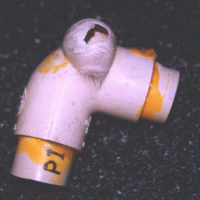PVC pipe is a durable material used in many construction and renovation applications. Despite its widespread use, problems can arise when manufacturer installation guidelines are not followed. This is especially true in applications that involve gluing joints or, using the more technical term, solvent welding.
Solvent is a liquid applied to PVC pipe so two pieces soften enough to fuse together. However, the solvent can weaken pipe if not applied correctly. Manufacturers provide detailed application instructions that help prevent such failures. Specifically, these instructions state solvent should be applied in a thin layer. Any excess should be pushed away from the fitting and wiped from the pipe’s exterior surface. Manufacturers also specify a minimum 24-hour curing time before pressurizing a piping system. If more solvent is used, more curing time is required.
These basic requirements were critical when we investigated a water damage loss at a medical practice. A few days after a plumbing company moved a sink a few feet down a wall, the water line below the building’s concrete slab failed. Was the loss caused by the work of the plumbing company?
During our investigation, we learned the crew fabricated a pipe extension using a tee fitting, a short section of PVC pipe, and a new angle valve. The work, which was assembled using solvent welding, occurred above the structure’s floor slab.
Inspecting the failed pipe below the slab, we made several discoveries. The compromised fitting contained a large amount of puddled, hardened solvent. The pipe’s exterior also showed red paint and foam overspray. We could clearly see a small, ballooned-out area where the rupture occurred. These discoveries told us the plumbing company’s renovation work did not lead to this loss. Rather, it was caused by faulty installation of the building’s plumbing system during construction.
Why? Excess solvent softened the pipe that eventually ruptured. Because the system was likely pressurized after only 24 hours of curing, the excess wasn’t taken into account and the system was pressurized before the solvent was fully cured. The softened pipe thinned and ballooned before failing. While the paint and foam overspray may be incompatible with PVC, neither would have been as significant a factor as the excess solvent.
While it seemed logical to draw a connection between the loss and recent plumbing work, in this case, it simply wasn’t true. The installers of the original system failed to heed well-known guidelines for using PVC and solvent. In this case, the damage was done long before the water damage occurred.
Founded in 1997, The Warren Group, forensic engineers and consultants provides technical investigations and analysis of personal injury and property claims as well as expert testimony for insurance adjusters and attorneys. Extremely well versed in the disciplines of mechanical, electrical, chemical, structural, accident reconstruction and fire and explosion investigation, our engineers and consultants are known for delivering the truth — origin, cause, responsibility and cost of an event or claim — with unmistakable clarity.





